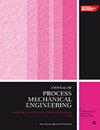Varying strain rates and elevated temperatures effects on the mechanical properties of AZ31B magnesium alloy
IF 2.2
4区 工程技术
Q2 ENGINEERING, MECHANICAL
Proceedings of the Institution of Mechanical Engineers, Part E: Journal of Process Mechanical Engineering
Pub Date : 2024-08-19
DOI:10.1177/09544089241271882
引用次数: 0
Abstract
This study investigates the monotonic tensile behavior of magnesium (Mg) alloy AZ31B across a temperature range from ambient (25 °C) to elevated (up to 300 °C) with varying strain rates (SR) (1.5 × 10不同应变率和高温对 AZ31B 镁合金机械性能的影响
本研究调查了镁(Mg)合金 AZ31B 在不同应变率(SR)(1.5 × 10-2 至 1.5 × 10-4 s-1)下,从环境温度(25 °C)到高温(最高 300 °C)范围内的单调拉伸行为。本研究调查了这些应变速率下的机械性能,如极限拉伸强度(σu)、拉伸屈服强度(σy)、破坏应变(εf)、塑性各向异性(r 值)、应变速率敏感性(m)和应变硬化指数(n)。随着温度从 25 ℃ 升至 300 ℃,观察到机械性能发生了以下变化:屈服强度(σy)降低了 84.50%,极限抗拉强度(σu)降低了 87%,弹性模量(E)降低了 63.0%,伸长率增加了 72.0%。针对上述机械性能提出了不同温度范围下的降低系数(RF)。利用场发射扫描电子显微镜(FE-SEM)研究了不同温度和应变率对断裂表面的影响。结果显示,随着温度的升高,出现了韧性网、裂纹和越来越多的凹陷。
本文章由计算机程序翻译,如有差异,请以英文原文为准。
求助全文
约1分钟内获得全文
求助全文
来源期刊
CiteScore
3.80
自引率
16.70%
发文量
370
审稿时长
6 months
期刊介绍:
The Journal of Process Mechanical Engineering publishes high-quality, peer-reviewed papers covering a broad area of mechanical engineering activities associated with the design and operation of process equipment.

 求助内容:
求助内容: 应助结果提醒方式:
应助结果提醒方式:


